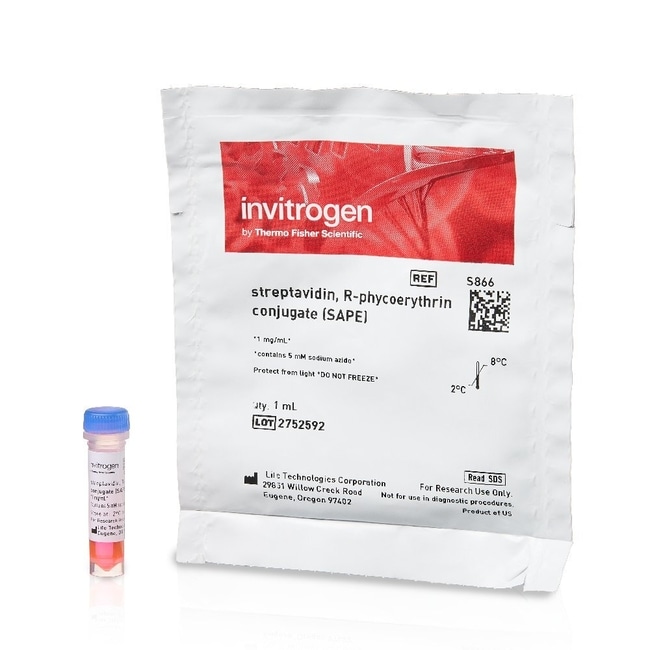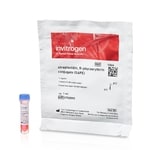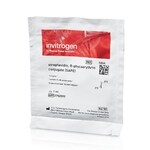Search Thermo Fisher Scientific
證書
SDS
引用資料與參考文獻 (197)
Invitrogen™
Streptavidin, R-Phycoerythrin Conjugate (SAPE) - 1 mg/mL
Streptavidin is a bacterially derived biotin-binding protein that exhibits less nonspecific binding than avidin. Phycoerythrin also known as R-Phycoerythrin (RPE)深入閱讀
| 產品號碼 | Quantity |
|---|---|
| S866 | 1 mL |
產品號碼 S866
價格 (HKD)
3,650.00
Each
Quantity:
1 mL
價格 (HKD)
3,650.00
Each
Streptavidin is a bacterially derived biotin-binding protein that exhibits less nonspecific binding than avidin. Phycoerythrin also known as R-Phycoerythrin (RPE) is an intensely bright phycobiliprotein isolated from red algae with absorption maxima at approximately 496, 546 and 565 nm, and a fluorescence emission maximum of ∼578 nm. Used in flow, microplate assays and microarrays, this has remained one of our top three selling products for decades—a proven performer that you can trust.
Important Features of Streptavidin RPE
• Biotin Detection with high quantum efficiency photoprotein
• 5–10 times brighter than organic fluors
• High water solubility
• Ideal for Flow, microarrays and microplate assays
• Also available as Premium grade with higher purity confirmed by HPLC (S21388)
Streptavidin and RPE
The high affinity of avidin, an egg-white protein, for biotin was first exploited in histochemical applications in the mid-1970s. Avidin, and its bacterial counterpart, streptavidin (from Streptomy cesavidinii), have since become standard reagents for diverse detection schemes. Streptavidin, a nonglycosylated 52,800-dalton protein, exhibits less nonspecific binding than avidin.
Rhodophyta Phycoerythrin (RPE) has a MW of 240,000 Daltons and has a quantum efficiency of 78% making it an incredibly bright reagent. However, the photostability is extremely poor and is not traditionally recommended for microscopy. But the broad absorption and bright orange signal may it ideal for flow, microplate and microarray applications whenever sensitive detection of biotins is required.
Learn more about avidin biotin detection in general
Learn more about SAV-RPE
Important Features of Streptavidin RPE
• Biotin Detection with high quantum efficiency photoprotein
• 5–10 times brighter than organic fluors
• High water solubility
• Ideal for Flow, microarrays and microplate assays
• Also available as Premium grade with higher purity confirmed by HPLC (S21388)
Streptavidin and RPE
The high affinity of avidin, an egg-white protein, for biotin was first exploited in histochemical applications in the mid-1970s. Avidin, and its bacterial counterpart, streptavidin (from Streptomy cesavidinii), have since become standard reagents for diverse detection schemes. Streptavidin, a nonglycosylated 52,800-dalton protein, exhibits less nonspecific binding than avidin.
Rhodophyta Phycoerythrin (RPE) has a MW of 240,000 Daltons and has a quantum efficiency of 78% making it an incredibly bright reagent. However, the photostability is extremely poor and is not traditionally recommended for microscopy. But the broad absorption and bright orange signal may it ideal for flow, microplate and microarray applications whenever sensitive detection of biotins is required.
Learn more about avidin biotin detection in general
Learn more about SAV-RPE
For Research Use Only. Not for use in diagnostic procedures.
規格
Concentration1 mg/mL
Product TypeStreptavidin Conjugate (fluorescent)
Quantity1 mL
Shipping ConditionWet Ice
ConjugateR-phycoerythrin
FormLiquid
Unit SizeEach
內容物與存放
Store at 2–6°C, DO NOT FREEZE
May be exposed to light for short periods of time.
May be exposed to light for short periods of time.
Have questions about this product? Ask our AI assisted search.
This is an AI-powered search and may not always get things right. You can help us make it better with a thumbs up or down on individual answers or by selecting the “Give feedback" button. Your search history and customer login information may be retained by Thermo Fisher and processed in accordance with our
Privacy Notice.
圖表

Flow cytometric analysis of human mononuclear cells using mouse anti human CD4 and Streptavidin RPE.
Customers who viewed this item also viewed
文件與下載
證書
依批號或部分批號搜尋
批號Certificate TypeDateCatalog Number(s)
3141858Certificate of AnalysisJun 17, 2025S866
2983163Certificate of AnalysisAug 28, 2024S866
2752592Certificate of AnalysisDec 22, 2023S866
2633516Certificate of AnalysisJul 26, 2023S866
2551349Certificate of AnalysisOct 28, 2022S866
顯示 5 個結果, 在上方搜尋特定憑證
安全資料表
SDS
Product Information
Molecular Probes® 手冊
引用資料與參考文獻 (197)
Search citations by name, author, journal title or abstract text
引用資料與參考文獻
Abstract
Hematopoietic potential of stem cells isolated from murine skeletal muscle.
Journal:Proceedings of the National Academy of Sciences of the United States of America
PubMed ID:10588731
We have discovered that cells derived from the skeletal muscle of adult mice contain a remarkable capacity for hematopoietic differentiation. Cells prepared from muscle by enzymatic digestion and 5-day in vitro culture were harvested, and 18 Ã 10(3) cells were introduced into each of six lethally irradiated recipients together with
SHAP potentiates the CD44-mediated leukocyte adhesion to the hyaluronan substratum.
Journal:The Journal of biological chemistry
PubMed ID:16702221
Journal:
PubMed ID:16473883
FDF03, a novel inhibitory receptor of the immunoglobulin superfamily, is expressed by human dendritic and myeloid cells.
Journal:Journal of immunology (Baltimore, Md. : 1950)
PubMed ID:10903717
Identification of kappa opioid receptors in the immune system by indirect immunofluorescence.
Journal:Proc Natl Acad Sci U S A
PubMed ID:7862634
'A method to visualize the kappa opioid receptor is described that uses a high-affinity fluorescein-conjugated opioid ligand and indirect immunofluorescence with the phycoerythrin fluorophore to amplify the signal. The mouse thymoma cell line R1E/TL8x.1.G1.OUAr.1 (R1EGO), which expresses the kappa 1 but not mu or delta opioid receptors, was used as
197 total citations






